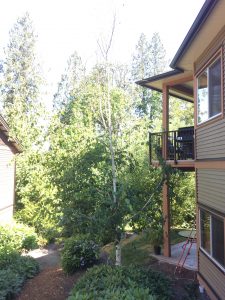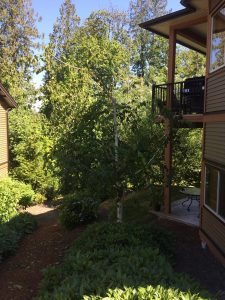Because I am ISA certified, tree-related tasks are automatically given to me by default. And that’s fine. This blog post is about a birch tree which exhibited top dieback. So I was sent in with pole pruners and an extendable Stihl chainsaw to take care of the request.
Once I took out all of the dead branches, I pruned the live parts of the tree to give it some sort of shape. Then I hauled out the debris up to the road for later truck pick up. Only later did I realize that my boss expected me to take the whole tree down! Not my style anyway.
Since we suspected the cause of the dieback to be the bronze birch borer (Agrilus anxius) my approach was correct. Pruning out affected limbs is the way to do it. I just couldn’t burn the diseased branches on a strata site surrounded by woods. My only hope is that no adults emerged before the debris was processed with other green waste.
Bronze birch borer
Adult bronze birch borers are half an inch long and have slender dark green bodies with metallic bronze sheen. In summer, females lay their eggs in bark crevices of weak and stressed birches. They prefer sunny, south facing branches.
Larvae hatch 14 days later, enter the bark and feed on sapwood. After one or two years adults emerge by chewing D-shaped holes in the bark.
Signs
So let’s review. Bronze birch borers cause treetop dieback, leaf wilting on branches and D-shaped exit holes in the bark
What can we do?
Since the bronze birch borer only picks on weak and stressed birches we should keep our birches in good shape with regular watering, feeding and pruning. Also, put your birches in shadier corners.
One other idea is to plant birch borer resistant river birch (Betula nigra) cultivars.
If you are lucky, you will get some help from natural allies like parasitic non-stinging wasps and woodpeckers.
The birch featured in this blog post is still alive and standing.
Source: GardenMaking magazine no.30, pp.56 and 58.






